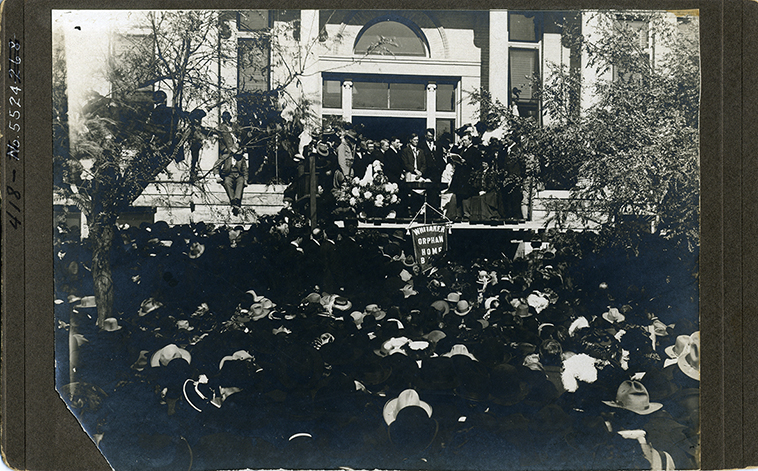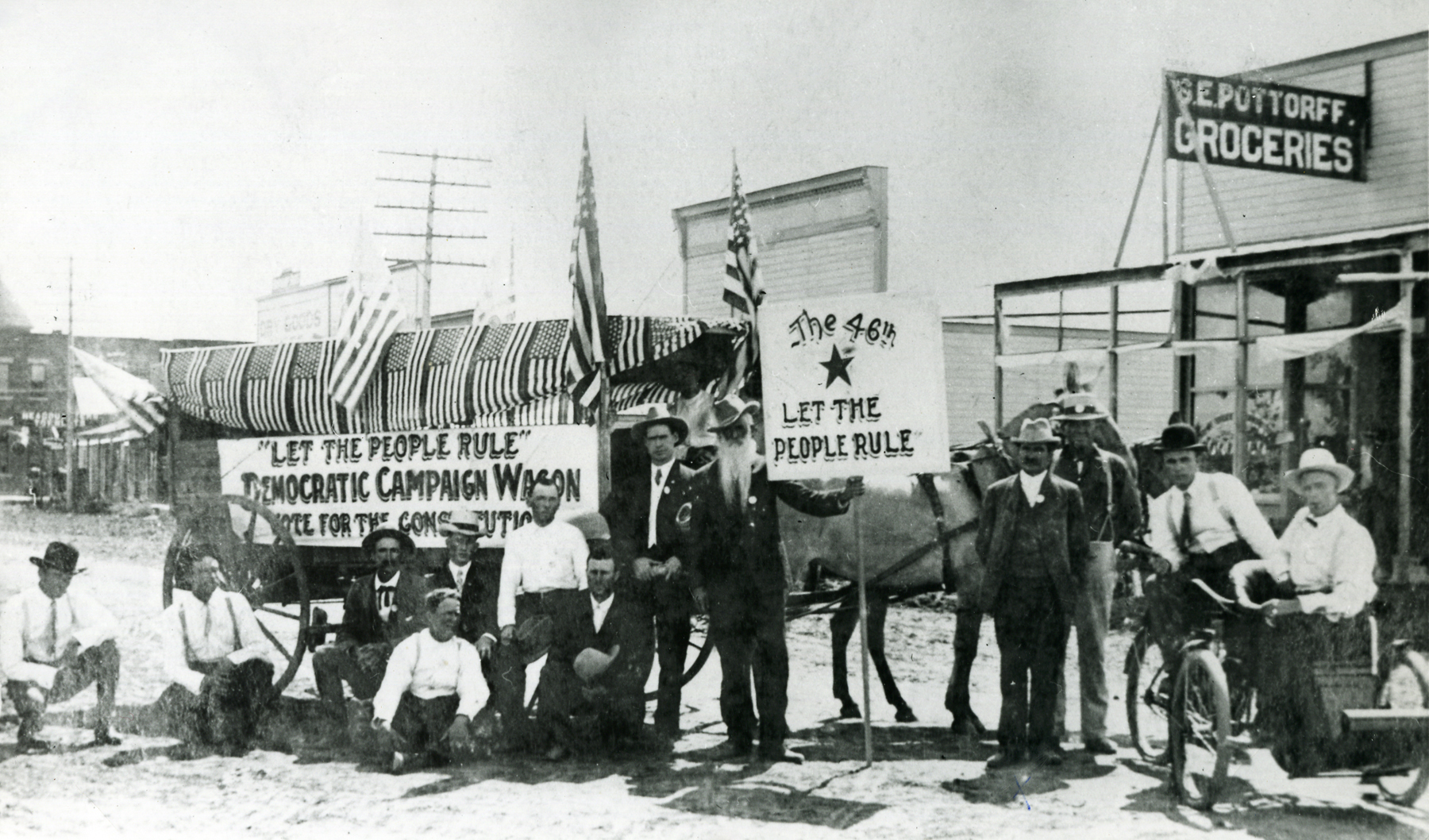The Encyclopedia of Oklahoma History and Culture
STATEHOOD MOVEMENT.
The greatest impetus for Oklahoma statehood began after the Land Run of 1889. Approximately fifty thousand non-Indian settlers made the run on April 22, 1889, into the Unassigned Lands (Oklahoma District). They began immediately to clamor for statehood in order to gain representation in Congress. The Organic Act of 1890 established a territorial government for Oklahoma Territory and defined the boundaries of Oklahoma Territory (O.T.) and Indian Territory (I.T.) comprising present Oklahoma. The law also called for the election of a non-voting delegate from O.T. to the U.S. House of Representatives.
Before the passage of the Oklahoma Enabling Act (1906), four statehood plans evolved. They included single statehood, double statehood, piecemeal absorption, and admission of O.T. to the Union without regard to I.T. Single statehood involved the joining of the two territories, whereas double statehood meant separate statehood for each territory. Numerous statehood conventions were held in O.T. and I.T. from 1891 to 1905. Of significance was the meeting called in 1903 at Shawnee, when delegates formed the Single Statehood Executive Committee and elected Charles G. Jones of Oklahoma City as chair. This group lobbied for three years until the Enabling Act passed in 1906. At the first statehood convention, held in Oklahoma City on December 15, 1891, delegates favored single statehood and wrote a memorial to Congress.
Consequently, in 1892 David A. Harvey, the first territorial delegate, submitted the memorial and introduced an unsuccessful bill in Congress calling for single statehood. Among those favoring the bill were Oklahoma City's Sidney Clarke and Guthrie's Horace Speed and William P. Hackney. Opposing the bill were Elias C. Boudinot (Cherokee), Roley McIntosh and Albert P. McKellop (Creek), and J. S. Standley (Choctaw). In 1902 delegate Dennis T. Flynn advocated a piecemeal absorption approach, asking for immediate statehood for O.T., with individual Indian nations in I.T. added to the state as they became ready for statehood.
The driving forces of politics and economics created an ever-changing situation and caused individuals to waver in their support of the different statehood plans. For example, Sidney Clarke initially favored single statehood but later supported statehood for O.T. with I.T. added at a future date. At the national level, opposition arose in Congress from eastern representatives who were concerned that the admission of O.T. would overturn their supremacy by increasing the number of western states. Southern Democratic representatives worried that O.T. would enter the Union with a strong Republican following. Others argued that the land area of O.T. was too small to be considered a state and that its resources of agriculture and cattle raising were too limited. In addition, there would be no tax base to support a state government for five years, because homesteaders were required to live on their claims for five years before receiving title to the land. Therefore, no taxes could be generated until 1894. In addition, allotments to American Indians in O.T. were held in trust by the federal government for twenty-one years and were exempt from taxes.
American Indians generally opposed federal attempts to organize them as a territory or a state. They wanted to retain their tribal governments and to continue their communal land ownership. Prior to the agitation for statehood in the 1890s, events in I.T. caused distress among the Five Tribes. As early as 1854 Arkansas Sen. Robert W. Johnson introduced a bill calling for the division of the Five Tribes' domain into three territories, allotting land in severalty to the American Indians, and selling surplus lands to non-Indian settlers. Later the three territories would be joined to form the state of Neosho. In the 1860s the federal government initiated steps toward governing the American Indians. Because some members of the Five Tribes supported the Confederacy during the Civil War, the tribes were required to sign new treaties with the United States after the war. The Reconstruction Treaties of 1866 and federal Indian policy envisioned the formation of an Indian territorial government. To thwart this, representatives of the I.T. nations met at Okmulgee, Creek Nation, in 1870 and drafted the Okmulgee Constitution, which provided for an elected governor, a bicameral legislature, and a court system. Although I.T. voters did not ratify the document, the event gave American Indian leaders experience that they applied during the future Sequoyah Convention.
As whites continued to move into I.T., their numbers increased from 110,254 in 1890 to 302,680 in 1900. They outnumbered American Indians by a ratio of 3 to 1 in 1890 and a ratio of 6 to 1 in 1900. While the Five Tribes retained their sovereignty, whites could not own land or vote. Whites complained of an inadequate justice system. Generally, no education for their children was available other than through subscription schools. Whites continued to follow party politics and attended national conventions, because they believed that I.T. would soon become a state. With statehood, a number of political offices would be offered to prominent party leaders.
As agitation for statehood continued in the 1890s, American Indian leaders and whites in Indian Territory (I.T.) favored double statehood. Indian leaders feared that if I.T. were added to O.T. to form one state, they would be outmaneuvered by the dominant political power in O.T. However, business owners in I.T. opposed double statehood, believing that they would receive the brunt of the tax burden, as American Indian land allotments would not be taxed for twenty-one years. When it became apparent that double statehood would not occur, whites clamored for the joining of the two territories to form a state.
Several events in the 1890s brought I.T. closer to statehood. In 1893 the Indian Appropriation Bill called for the Dawes Commission to meet with the Five Tribes to start the allotment process. Through the Atoka Agreement, ratified in 1897, the Choctaw and Chickasaw Nations agreed to take their lands in severalty. In 1898 Congress passed the Curtis Act, which called for the abolishment of tribal governments on March 4, 1906. Realizing that their governments would soon be defunct, leaders of the Five Tribes convened the Sequoyah Convention in August 1905 in Muskogee to write a constitution and to write a memorial to Congress for separate statehood for I.T.
The Sequoyah Convention constitution was not acknowledged by the U.S. Congress, due to party politics. Indian Territory was bordered by two southern Democratic states, Arkansas to the east and Texas to the south. Consequently, Pres. Theodore Roosevelt, a Republican, and the Republican-controlled Congress wanted joint statehood to eliminate the possibility of I.T. joining the Union as a Democratic state. On June 16, 1906, President Roosevelt signed the Oklahoma Enabling Act, which provided for the writing of a constitution for a state to be formed from the merging of Indian and Oklahoma territories.
Bibliography
Thomas H. Doyle, "Single Versus Double Statehood," The Chronicles of Oklahoma 5 (March, June, and September 1927).
Charles Ellinger, "Political and Economic Influences On the Statehood Movement in Oklahoma" (M.A. thesis, University of Oklahoma, 1960).
Charles Wayne Ellinger, "Congressional Viewpoint Toward the Admission of Oklahoma As a State: 1902–1906," The Chronicles of Oklahoma 58 (Fall 1980).
Charles Wayne Ellinger, "The Drive for Statehood in Oklahoma, 1889–1906," The Chronicles of Oklahoma 41 (Spring 1963).
Arrell M. Gibson, Oklahoma: A History of Five Centuries (2d ed.; Norman: University of Oklahoma Press, 1981).
"Statehood (American Politics) Oklahoma," Vertical File, Research Division, Oklahoma Historical Society, Oklahoma City.
Dora Ann Stewart, The Government and Development of Oklahoma Territory (Oklahoma City: Harlow Publishing Co., 1933).
Citation
The following (as per The Chicago Manual of Style, 17th edition) is the preferred citation for articles:
Linda D. Wilson, “Statehood Movement,” The Encyclopedia of Oklahoma History and Culture, https://www.okhistory.org/publications/enc/entry?entry=ST025.
Published January 15, 2010
© Oklahoma Historical Society



